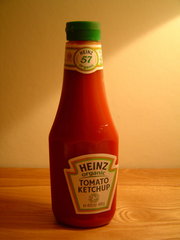» View the recipes involving catsup
 Ketchup (or catsup) is a popular condiment, usually made with ripened tomatoes. The basic ingredients in modern ketchup are tomatoes, vinegar, sugar, salt, allspice, cloves, and cinnamon. Onions, celery, and other vegetables are frequent additions. In Australia, South Africa, New Zealand and the UK, ketchup is commonly referred to as tomato sauce. Ketchup (or catsup) is a popular condiment, usually made with ripened tomatoes. The basic ingredients in modern ketchup are tomatoes, vinegar, sugar, salt, allspice, cloves, and cinnamon. Onions, celery, and other vegetables are frequent additions. In Australia, South Africa, New Zealand and the UK, ketchup is commonly referred to as tomato sauce.
Ketchup has not always been made out of tomatoes. It started out as a general term for sauce, typically made of mushrooms or fish brine with herbs and spices. Some popular early main ingredients include anchovy, oyster, lobster, walnut, kidney bean, cucumber, cranberry, lemon, and grape. Heinz introduced the first commercial ketchup in 1876 which was advertised: "Blessed relief for Mother and the other women in the household!" Modern ketchup emerged in the early years of the 20th century, out of a debate over the use of sodium benzoate as a preservative in condiments. Harvey W. Wiley, the "father" of the Food and Drug Administration in the U.S., challenged the safety of benzoate. In response, entrepreneurs, particularly Henry J. Heinz, pursued an alternative recipe that eliminated the need for that preservative. Prior to Heinz (and his fellow innovators), commercial tomato ketchups of that time were watery and thin, in part due to the use of unripe tomatoes, which were low in pectin. They were also less vinegary than modern ketchups; by pickling ripe tomatoes, the need for benzoate was eliminated without spoilage or degradation in flavor. But the changes driven by the desire to eliminate benzoate also produced changes that some experts (such as Andrew F. Smith ) believe were key to the establishment of tomato ketchup as the dominant American condiment. Until Heinz, most commercial ketchups appealed to two of the basic tastes: bitterness and saltiness. But the switch to ripe tomatoes and more tomato solids added savoriness, and the major increase in the concentration of vinegar added sourness and pungency to the range of sensations experienced during its consumption. And because the elimination of benzoate was also accompanied by a doubling of the sweetness of ketchup, a balanced stimulation of all five types of taste buds produced an almost gestalt effect. In the past, ketchup was produced from fresh tomatoes after harvesting. Vacuum evaporation made it possible to turn tomatoes into a very thick tomato paste that is easy to store at room temperature. This enables a factory to produce ketchup throughout the year.
Season specials: Easter Recipes, Passover Recipes, Christmas Recipes, Season Recipes, Xmas Recipes
|